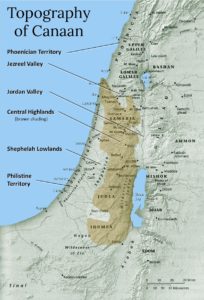Today we begin Numbers Chapter 34.
For the Complete Jewish Bible, click here.
For the King James version, click here.
“Your southern portion will extend from the Tzin Desert close to the border of Edom. The eastern terminus of your southern border is at the end of the Dead Sea. From there your border turns, goes south of the ‘Akrabbim Ascent and passes on to Tzin. From there it goes south of Kadesh-Barnea, on to Hatzar-Adar, and on to ‘Atzmon. Then the border turns and goes from ‘Atzmon to the Vadi of Egypt and along it to the Sea.”-Numbers 34:3-5
The first 12 verses of Numbers Chapter 34 deal with the basic borderline boundaries defining the Promised Land.
Although many of the points defined are not known today, there are some points we do know with certainty.
First of all, the Jordan River on the east side and Mediterranean Sea on the west side are easy to recognize.
And we’re pretty confident in the points identified in the Northern Territory of Canaan.
However, when we come to the southern boundary of Canaan, a bit of confusion ensues.
So I’d like to deal with that subject today.
Before we dive in though, you should know that we have access to ancient Egyptian maps from around this same era dating back to around the 14th century BC.
And when these maps are examined, wouldn’t you know it, they PERFECTLY MATCH THE DESCRIPTION OF THE BOUNDARIES WE READ ABOUT HERE IN NUMBERS 34.
This extra-biblical evidence more than substantiates that what the Torah tells us here is accurate.
Not only that, we can know with certainty that what is described here in Numbers 34 was the commonly accepted territorial boundaries of the Land of Canaan all the way up to the day when Israel invaded the land per divine decree.
In other words, when HASHEM defined the boundaries of the land of Canaan, he neither added to nor subtracted from what already had been established.
Now let’s get down to dealing with the confusion and fuzziness concerning the southern boundary.
Take a look at verse 5.
“Then the border turns and goes from ‘Atzmon to the Vadi of Egypt and along it to the Sea”
The semi-English phrase “Vadi of Egypt” is in the original Hebrew rendered as NAHLAH MISHRAYIM.
It is this point right here that represents one of the biggest controversies ever concerning the southern boundary of Canaan.
Some scholars will say that NAHLAH MISHRAYIM is referring to the Nile River and some will say it isn’t.
So who’s right?
Well, there are FOUR GOOD REASONS why NAHLAH MISHRAYIM cannot be referring to the Nile River in Egypt and here they are:
1ST REASON:
Nowhere and I mean NOWHERE do we ever see the phrase “NAHLAH MISHRAYIM” used to refer to the Nile River (honestly, this should end the argument right here).
2ND REASON:
NAHLAH is NOT a term used to describe a river as big as the Nile River was. It simply means a watercourse and can be used to denote a brook, stream, or some other small water channel. (It isn’t used to refer to a desert Wadi except in those rare instances when a thunderstorm occurs and suddenly fills up the dry riverbed with water).
3RD REASON:
If the NAHLAH MISHRAYIM was actually the Nile River in Egypt, that means the boundaries of Canaan once extended to include not only the entire Sinai Peninsula but also covered the African continent, which would cover territory always belonged to Egypt. Didn’t God forbid Israel from ever going back to Egypt? Naw man, I don’t think this duck is gonna fly.
4TH REASON:
This point will make you laugh. If Canaan had really included the Sinai Peninsula (or even the eastern bank of the River Nile), then that would mean the Sinai Peninsula was part of the Promised Land. And you know what that means? It means that when Israel left Pharaoh’s grip, their journey from Egypt to the Promised Land would have been over in only a couple of days, practically before the trip even started. (Again, I remind you that ancient Egyptian maps and records are practically identical to what’s recorded here in Numbers 34).
What’s the conclusion of the matter?
While there may be more plausible explanations concerning what exactly NAHLAH MISHRAYIM could have been referring to, one argument that doesn’t hold any water is to say that it somehow extended all the way into the Sinai which has always been considered Egyptian territory.
I’m done.




Leave a Reply